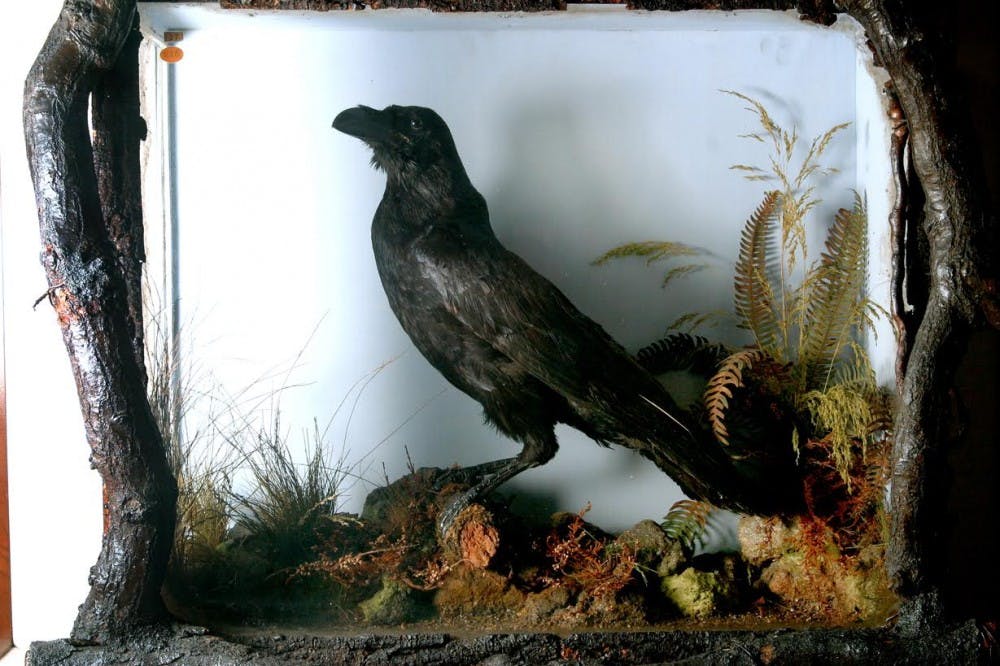A dead bird sits in the Rare Book Department of the Free Library of Philadelphia: a massive, glossy–looking dead raven named Grip.
Grip was the beloved pet of Charles Dickens, author of David Copperfield and A Tale of Two Cities. According to Karen Kirsheman, a librarian at the Free Library, Grip was “allowed to run around the house like a dog or cat would.” Before he was a pet, though, Grip served as a character study for a raven in Dickens’ Barnaby Rudge, as Dickens wished to understand the bird’s movements and nature.
Grip enchanted Dickens and his family with his wily behavior and ability to imitate human speech (his favorite phrase was “Halloa old girl”). The bird was so comfortable that it eventually developed the habit of biting people’s ankles, a habit that banished Grip to the stables on Dickens’ property. The stables were in the process of being painted white at the time, though, and Grip is believed to have unwisely consumed paint. He shortly passed away, presumably due to lead poisoning.
“You will be greatly shocked and grieved to hear that the Raven is no more,” laments Dickens in a letter to the painter Daniel Maclise, dated March 12, 1841. The bird’s death affected him significantly, to the point that he ordered a postmortem examination to look into whether the death could be ruled a poisoning. “This is actually Grip number 1,” explained Kirsheman. Apparently, after Grip’s demise, Dickens had two more pet ravens, each also named Grip.
Grip’s influence goes beyond just Dickens, though. In 1841, Edgar Allan Poe, who was living in Philadelphia at the time, became an editor of Graham’s Ladies and Gentlemen’s Magazine, in which Barnaby Rudge was serialized. Poe reviewed the novel favorably, but felt that the raven’s, “...croakings might have been prophetically heard in the course of the drama.” Four years later, Poe developed his own prophetically croaking bird in “The Raven”—a poem that Grip likely (but not definitely) inspired.
And though Grip undoubtedly held a role in literary history, he languished for over twenty years in the Free Library’s storage space under a canvas marked “The Most Famous Bird in the World.” He ended up at the Library at the bequest of Col. Richard Gimbel (of the department store fortune) along with Gimbel’s extensive Poe collection, which included Poe’s Philadelphia house on what is now 7th and Spring Garden Streets (and is now a National Park Site and open to visitors). Grip was rescued from storage, cleaned up, and displayed lovingly again as he had been for years in the different homes of Charles Dickens.
“People come in just to see Grip—like a pilgrimage,” Kirsheman mentioned. And the bird, hidden away in the back corner of a massive and monumental library, does have an unexpected magnetism: a religious quality that’s almost funny.
Grip, whose 176th death anniversary will be coming up this March, will continue to peer out from his glassy eyes, tucked away in a corner of the Free Library—a strange and obscure altar to literature, memorialized with every utterance of the famous words "Quoth the Raven."
The Rare Book Department of the Free Library of Philadelphia is located on the third floor of the Central Library at 19th and Vine Streets. Its hours are 9:00 a.m. to 5:00 p.m., Monday through Friday. Tours are offered daily at 11:00 a.m.
The Department's new exhibition, Becoming the Detective: The Making of a Genre, will open Saturday, April 8 and run until Friday, September 1.







